5.1 The Impacts of Social Class
In the United States, a person’s social class has far-reaching consequences. Social class refers to the the grouping of individuals in a stratified hierarchy based on wealth, income, education, occupation, and social network (though other factors are sometimes considered) (“Hierarchy,” 2019). One’s position in the social class hierarchy may impact, for example, health, family life, education, religious affiliation, political participation, and experience with the criminal justice system.
Social class in the United States is a controversial issue, with social scientists disagreeing over models, definitions, and even the basic question of whether or not distinct classes exist. Many Americans believe in a simple threeclass model that includes the rich or upper class, the middle class, and the poor or working class (“Social Class,” 2020). More complex models that have been proposed by social scientists describe as many as a dozen class levels. Regardless of which model of social classes used, it is clear that socioeconomic status (SES) is tied to particular opportunities and resources. Socioeconomic status refers to a person’s position in the social hierarchy and is determined by their income, wealth, occupational prestige, and educational attainment.
While social class may be an amorphous and diffuse concept, with scholars disagreeing over its definition, tangible advantages are associated with high socioeconomic status. People in the highest SES bracket, generally referred to as the upper class, likely have better access to healthcare, marry people of higher social status, attend more prestigious schools, and are more influential in politics than people in the middle class or working class. People in the upper class are members of elite social networks, effectively meaning that they have access to people in powerful positions who have specialized knowledge. These social networks confer benefits ranging from advantages in seeking education and employment to leniency by police and the courts. Sociologists may dispute exactly how to model the distinctions between socioeconomic statuses, but the higher up the class hierarchy one is in America, the better health, educational, and professional outcomes one is likely to have (“Social Class,” 2020).
Physical Health
A person’s social class has a significant impact on their physical health, their ability to receive adequate medical care and nutrition, and their life expectancy. While gender and race play significant roles in explaining healthcare inequality in the United States, SES is the greatest social determinant of an individual’s health outcome. Social determinants of health are the economic and social conditions that influence individual and group differences in health status. Social determinants are environmental, meaning that they are risk factors found in one’s living and working conditions (including the distribution of income, wealth, influence, and power), rather than individual factors (such as behavioral risk factors or genetics). Social determinants can be used to predict one’s risk of contracting a disease or sustaining an injury, and can also indicate how vulnerable one is to the consequences of a disease or injury (“Social Determinants of Health,” 2019). Individuals of lower socioeconomic status have lower levels of overall health, less insurance coverage, and less access to adequate healthcare than those of higher SES (Figure 5.1).
Individuals with a low SES in the United States experience a wide array of health problems as a result of their economic position (“Health Equity,” 2020). They are unable to use healthcare as often as people of higher status and when they do, it is often of lower quality. Additionally, people with low SES tend to experience a much higher rate of health issues than those of high SES (“Social Class,” 2020). Many social scientists hypothesize that the higher rate of illness among those with low SES can be attributed to environmental hazards. For example, poorer neighborhoods tend to have fewer grocery stores and more fast food chains than wealthier neighborhoods, increasing nutrition problems and the risk of conditions, such as heart disease (“Health Equity,” 2020). Similarly, poorer neighborhoods tend to have fewer recreational facilities and higher crime rates than wealthier ones, which decreases the feasibility of routine exercise.
In addition to having an increased level of illness, lower socioeconomic classes have lower levels of health insurance than the upper class. Much of this disparity can be explained by the tendency for middle and upper class people to work in professions that provide health insurance benefits to employees, while lower status occupations often do not provide benefits to employees. For many employees who do not have health insurance benefits through their job, the cost of insurance can be prohibitive. Without insurance, or with inadequate insurance, the cost of healthcare can be extremely high. Consequently, many uninsured or poorly insured individuals do not have access to preventative care or quality treatment. This group of people has higher rates of infant mortality, cancer, cardiovascular disease, and disabling physical injuries than are seen among the well insured (“Health Care in the United States,” 2020).
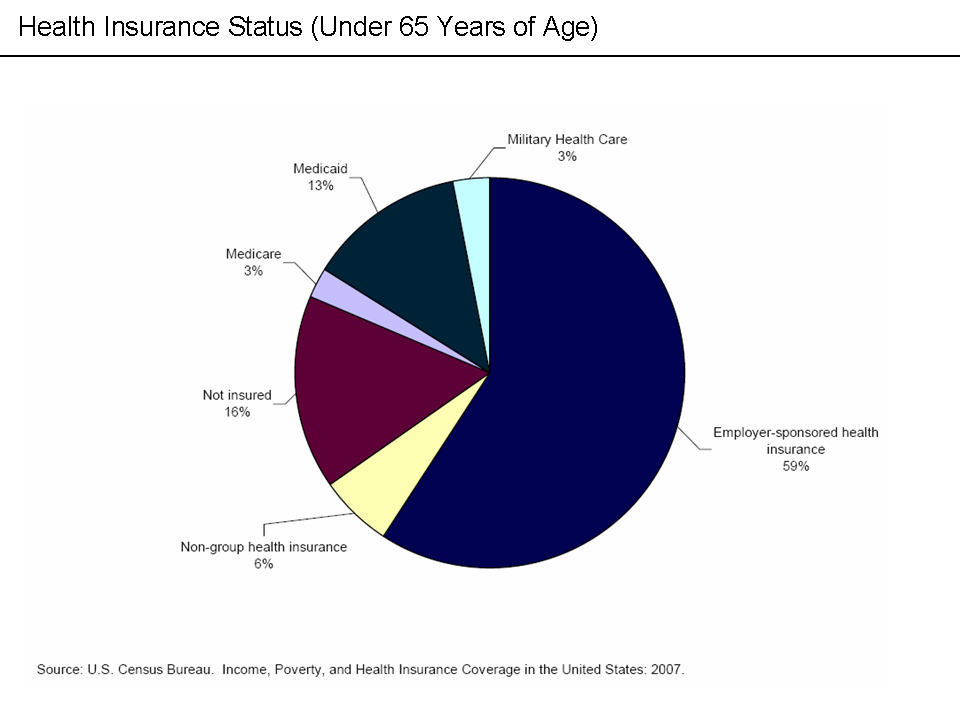

Health inequality refers to the unequal distribution of environmental health hazards and access to health services between demographic groups, including social classes. For example, poor and affluent urban communities in the United States are geographically close to each other and to hospitals. Still, the affluent communities are more likely to have access to fresh produce, recreational facilities for exercise, preventative healthcare programs, and routine medical visits. Consequently, affluent communities are likely to have better health outcomes than nearby impoverished ones. The role of socioeconomic status in determining access to healthcare results in heath inequality between the upper, middle, and lower or working classes, with the higher classes having more positive health outcomes (“Health Equity,” 2020).
Mental Health
Mental health describes a level of psychological well-being or the presence/absence of a mental disorder (“Mental Health,” 2018). From the perspective of “positive psychology” or “holism,” mental health may include an individual’s ability to enjoy life and to demonstrate psychological resilience when confronted with challenges. The World Health Organization defines mental health as “a state of well-being in which the individual realizes his or her own abilities, can cope with the normal stresses of life, can work productively and fruitfully, and is able to make a contribution to his or her community” (“Mental Health,” 2020).
What counts as healthy enjoyment and resilience depends upon one’s class perspective. Members of different classes encounter different stressors—lower class people likely face more financial stress as it pertains to day-to-day sustenance and well-being, while upper class people might experience stress from the intense social pressures associated with elite circles. The evaluation of which mental states can be considered healthy and which require medical intervention also varies by class.
Mental health is a socially constructed and socially defined concept; different societies, groups, cultures, institutions, and professions have very different ways of conceptualizing its nature and causes, determining what is mentally healthy, and deciding what interventions are appropriate. Definitions of mental health depend on cultural understandings in addition to biological and neurological findings. Members of different social classes often hold different views on mental health. Similarly, different social classes have different levels of access to mental health interventions and to information about mental health. Thus, the diagnosis and treatment of mental disorders varies widely by social class.
Family Life
Family life—marriage and childbearing patterns, household composition, and home stability—are strongly influenced by social class (“Introduction to Sociology/Family,” 2017). In the United States, the probability of a first marriage ending is substantially higher for couples with low socioeconomic statuses than for those in the middle or upper class. Research shows that the higher rates of divorce for individuals in lower social classes can often be attributed to the greater financial stress these couples face, though factors like class expectations can also play a role.
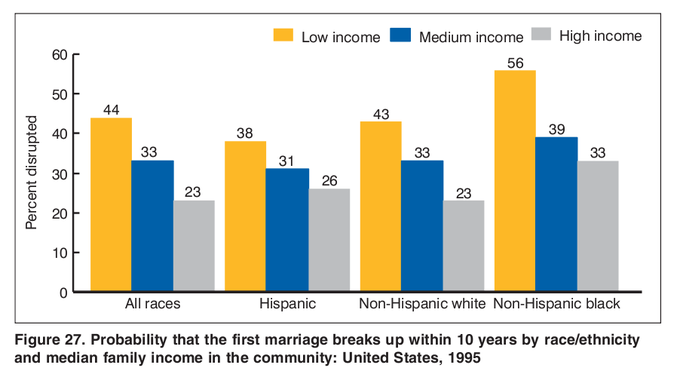
Globally, the birth rate in countries with large impoverished populations is much higher than in wealthier countries, indicating that income and wealth play a role in shaping family structures. Demographers have identified a direct relationship between average number of children per household and the economic development of a nation. Today, less developed countries struggle with overpopulation while many governments in developed countries are instituting policies to deal with low birth rates. In nations with high levels of fertility, upper class individuals tend to have more children than their lower class peers. In nations with low levels of fertility, upper class families exhibit even lower fertility than average (“Birth Rate,” 2020).
Social class has both a cause and an effect relationship with family composition (“Introduction to Sociology/ Family,” 2017). For example, single-parent households are likely to have a lower social class because they violate social norms. At the same time, single-parent families can contribute to financial and social instability. A single parent will often face higher costs (in the form of paid childcare), lower earnings (loss of the second parent’s income or loss of time spent at work), or both.
Education
Education is a major component of social class, both directly and indirectly. Directly, individuals from higher social classes are more likely to have the means to attend more prestigious schools, and are therefore more likely to receive higher educations (“Social Class,” 2020). Indirectly, individuals who benefit from such higher education are more likely to land prestigious jobs, and in turn, higher salaries. Just as education and social class are closely intertwined, stratification in education contributes to stratification in social class.
Educational attainment refers to the level of schooling a person completes—for instance, high school, some college, college, or a graduate degree. Upper class individuals are likely to attend schools of higher quality and of greater prestige than those attended by their lower class counterparts (“Educational Attainment in the United States,” 2020). Because members of high social classes tend to be better educated and have higher incomes, they are able to offer greater educational advantages, such as private schooling, to their children as well (Figure 5.3).
Upper-class parents are better able to send their children not only to exclusive private schools, but also to public state-funded schools. Such schools are likely to be of higher quality in affluent areas than in impoverished ones, since they are funded by property taxes within the school district. Wealthy areas will provide more property taxes as revenue, which leads to higher quality schools. Educational inequality is one factor that perpetuates the class divide across generations.
Such educational inequality is further reinforced by legacy student admission, the preference given by educational institutions to applicants who are related to alumni of that institution (“Legacy Preferences,” 2020). Germane to university and college admissions (particularly in the United States), this practice emerged after World War I, primarily in response to the resulting immigrant influx. Ivy League institutions admit roughly 10% to 30% of students from each incoming class based on this factor.
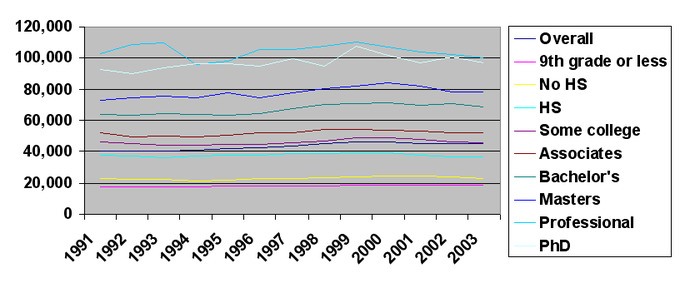
Religion
Social class, measured by socioeconomic status, is associated with individuals’ religious affiliations and practices. Religious affiliation has more to do with how religion is practiced rather than degree of religiosity (“Introduction to Sociology/Religion,” 2018). Members of lower classes tend to be affiliated with more fundamentalist religions and sect-like groups. Members of the middle class tend to belong to more formal churches. For example, American Presbyterians and Episcopalians (two highly formal Protestant denominations), tend to have above average socioeconomic statuses. Methodists and Lutherans (two moderately formal Protestant denominations) tend to have about average SES. Baptists and members of Protestant fundamentalist sects (which tend to be decentralized and informal) have below average SES (“Introduction to Sociology/Religion,” 2018). Variations in SES across denomination reveal a correlation between religious affiliation and social class.
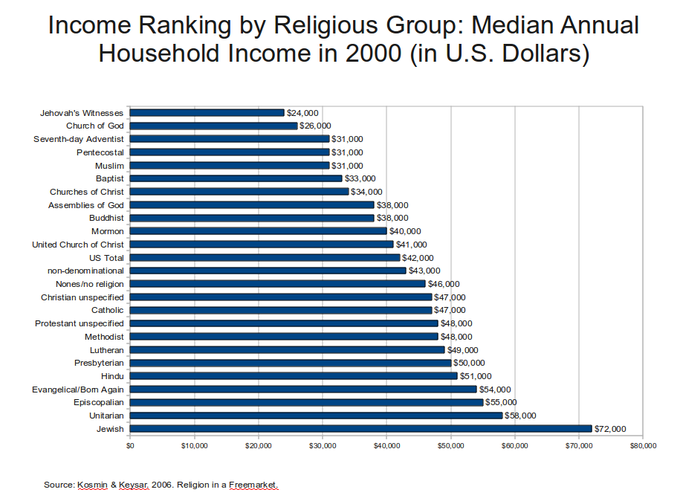
Social class is not significantly correlated to religiosity, an index of how strongly religious a person is. Religiosity is measured by tracking frequency of church attendance, church group involvement, frequency of prayer, and other such markers of strength of religious practice. Members of each social class show a range of religiosity.
On the other hand, income, and therefore social class, is related to an individual’s denomination. When one looks at average income by religion, there are clear differences. The highest-earning religion on average is Judaism, with an average income of $72,000 in 2000. This is dramatically higher than average; the next highest-earning denomination is Unitarianism at $56,000. Jehovah’s Witness, Church of God, and Seventh Day Adventists are at the bottom of the income distribution, with $24,000, $26,000, and $31,000, respectively (“Introduction to Sociology/Religion,” 2018).
Religion is also linked with education. 72% of Unitarian and 67% of Hindu adherents are college graduates, while only 12% of Jehovah’s Witness and 15% of Church of God members graduated from college (“Introduction to Sociology/Religion,” 2018).
Politics
Social class impacts one’s level of political participation and political influence. Political participation refers to whether or not a person votes in elections, donates to campaigns, or attends public forums where decisions are made, such as town meetings or city council meetings, for example. Political influence refers to the extent to which one’s political participation achieves its desired results. For example, if one attends a public forum, is their opinion likely to be heard, or if they donate money, is a politician likely to support their desired policy?
Wealthy, well-educated Americans are more likely to vote and to donate money to politicians than lower class individuals (Figure 5.5). This trend means that middle and upper class individuals have greater political participation and greater political influence than those in lower positions. Additionally, higher status people are more likely to hold political positions than lower class people. An illustration of this is the presidential election between George W. Bush and John Kerry in 2004. Both had millions of dollars of accumulated wealth, and they had higher degrees from Harvard and Yale, respectively (“Introduction to Sociology/Politics,” 2017).
Those who vote as members of a social class can be said to be participating in identity politics. Identity politics is a phenomenon that arose first at the radical margins of liberal democratic societies in which human rights are recognized, and the term is not usually used to refer to dissident movements within single-party or authoritarian states. Some groups have combined identity politics and Marxist social class analysis and class consciousness. During the 1980s, the politics of identity became very prominent and was linked with new social movement activism (“Identity Politics,” 2020).
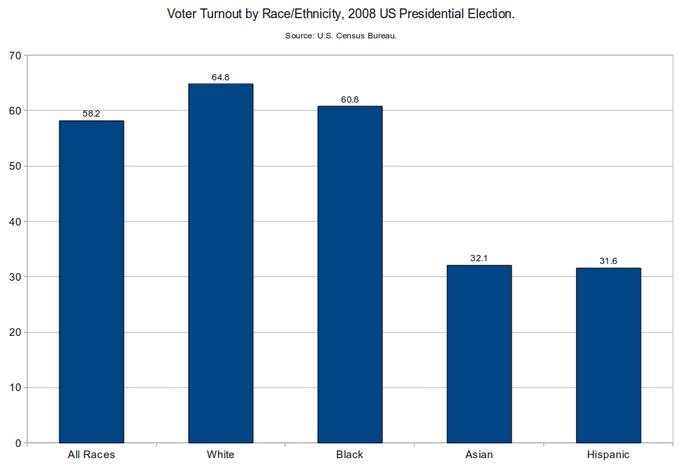

FIGURE 5.5 Percentage of voter turnout by educational attainment (2008 presidential election). Educational attainment, an indicator of social class, can predict one’s level of political participation. Those with high educational attainment are more likely to vote in elections than those with little education. (This work, Voter Turnout by Education 2008, is a derivative of Voter Turnout by Educational Attainment, 2008 US Presidential Election by Rcragun/Wikimedia Commons, which is used under CC BY 3.0. Voter Turnout by Education 2008 is licensed under CC BY-SA 4.0 by Judy Schmitt.)]
Crime and Criminal Justice
Criminal justice is the system of practices and government institutions directed at upholding social control, deterring, and mitigating crime, or sanctioning those who violate laws with criminal penalties and rehabilitation efforts. The American criminal justice system consists of three main parts: (1) enforcement; (2) adjudication; and (3) corrections. These distinct agencies are the principal means of maintaining the rule of law within society (“Criminal Justice,” 2020).
The first contact an offender has with the criminal justice system is usually with law enforcement, most often the police who investigate a suspected violation and make an arrest. Next, the courts carry out adjudication or the legal processing of offenders to determine their guilt or innocence and sentencing. The courts serve as the venue where disputes are settled and justice is administered. Depending on the offense, either a judge or a jury determines whether the suspect violated the law and what their punitive sentence will be. If found guilty by the court, offenders are then turned over to correctional authorities. Correctional authorities may include prison wardens or social workers, depending on the type of offense (“Criminal Justice,” 2020).
Like all other aspects of criminal justice, the administration of punishment has taken many different forms throughout history. Early on, when civilizations lacked the resources necessary to construct and maintain prisons, exile and execution were the primary forms of punishment. Historically, shame punishments have also been used as forms of censure (“Criminal Justice,” 2020).
The most publicly visible form of punishment in the modern era is the prison. Prisons may serve as detention centers for prisoners after trial. Jails are used for containment of the accused before trial. Early prisons were used primarily to sequester criminals and little thought was given to living conditions within their walls. In America, the Quaker movement is commonly credited with establishing the idea that prisons should be used to reform criminals. This can also be seen as a critical moment in the debate regarding the purpose of punishment (“Criminal Justice,” 2020).
In the United States, criminal justice policy has been guided by the 1967 President’s Commission on Law Enforcement and Administration of Justice, which issued a ground-breaking report titled The Challenge of Crime in a Free Society. This report made more than 200 recommendations as part of a comprehensive approach toward crime prevention. Some of those recommendations found their way into the Omnibus Crime Control and Safe Streets Act of 1968. The commission advocated a “systems” approach to criminal justice, with improved coordination among law enforcement, courts, and correctional agencies. The commission defined the criminal justice system as the means for society to “enforce the standards of conduct necessary to protect individuals and the community” (President’s Commission, 1967, p. 7).
References
Birth rate. (2020, January 29). In Wikipedia. https://en.wikipedia.org/w/index.php?title=Birth_rate&oldid=938230085
Criminal justice. (2020, January 9). In Wikipedia. https://en.wikipedia.org/w/index.php?title=Criminal_justice&oldid=934990442
Educational attainment in the United States. (2020, January 29). In Wikipedia. https://en.wikipedia.org/w/index.php?title=Educational_attainment_in_the_United_States&oldid=938187143
Health care in the United States. (2020, February 9). In Wikipedia. https://en.wikipedia.org/w/index.php?title=Health_care_in_the_United_States&oldid=939993144
Health equity. (2020, February 17). In Wikipedia. https://en.wikipedia.org/w/index.php?title=Health_equity&oldid=941219790
Hierarchy. (2019, September 29). In Wiktionary. https://en.wiktionary.org/w/index.php?title=hierarchy&oldid=54378944
Identity politics. (2020, February 17). In Wikipedia. https://en.wikipedia.org/w/index.php?title=Identity_politics&oldid=941294253
Introduction to sociology/family. (2017, August 16). In Wikibooks. https://en.wikibooks.org/w/index.php?title=Introduction_to_Sociology/Family&oldid=3269745
Introduction to sociology/politics. (2017, August 6). In Wikibooks. https://en.wikibooks.org/w/index.php?title=Introduction_to_Sociology/Politics&oldid=3259674
Introduction to sociology/religion. (2018, July 14). In Wikibooks. https://en.wikibooks.org/w/index.php?title=Introduction_to_Sociology/Religion&oldid=3442359
Social class. (2020, February 9). In Wikipedia. https://en.wikipedia.org/w/index.php?title=Social_class&oldid=939931063#Consequences_of_class_position
Social determinants of health. (2019, December 14). In Wikipedia. https://en.wikipedia.org/w/index.php?title=Social_determinants_of_health&oldid=930655316
Legacy preferences. (2020, February 17). In Wikipedia. https://en.wikipedia.org/w/index.php?title=Legacy_preferences&oldid=941192697
Mental health. (2018, October 28). In Wiktionary. https://en.wiktionary.org/w/index.php?title=mental_health&oldid=50594437
Mental health. (2020, February 10). In Wikipedia. https://en.wikipedia.org/w/index.php?title=Mental_health&oldid=940015217
President’s Commission on Law Enforcement and Administration of Justice. (1967). The challenge of crime in a free society: A report. U.S.
Government Printing Office. https://www.ncjrs.gov/pdffiles1/nij/42.pdf
Lumencandela. (n.d.). The impacts of social class. In Boundless sociology. Lumen Learning. https://courses.lumenlearning.com/boundless-sociology/chapter/the-impacts-of-social-class/
(Creative Commons Attribution-ShareAlike 4.0 International License)
CC LICENSED CONTENT, SHARED PREVIOUSLY
- Curation and Revision. Provided by: Boundless.com. License: CC BY-SA: Attribution-ShareAlike
CC LICENSED CONTENT, SPECIFIC ATTRIBUTION
- Social class. Provided by: Wikipedia. Located at: https://en.wikipedia.org/wiki/Social_class#Consequences_of_class_position. License: CC BY-SA: Attribution-ShareAlike
- hierarchy. Provided by: Wiktionary. License: CC BY-SA: Attribution-ShareAlike
- socioeconomic. Provided by: Wiktionary. License: CC BY-SA: Attribution-ShareAlike
- Social determinants of health. Provided by: Wikipedia. License: CC BY-SA: Attribution-ShareAlike
- Health and Social Class. Provided by: Wikipedia. License: CC BY-SA: Attribution-ShareAlike
- Social class. Provided by: Wikipedia. License: CC BY-SA: Attribution-ShareAlike
- Health and Social Class. Provided by: Wikipedia. License: CC BY-SA: Attribution-ShareAlike
- Boundless. Provided by: Boundless Learning. License: CC BY-SA: Attribution-ShareAlike
- Boundless. Provided by: Boundless Learning. License: CC BY-SA: Attribution-ShareAlike
- Boundless. Provided by: Boundless Learning. License: CC BY-SA: Attribution-ShareAlike
- SOJ Farmers Market | Flickr – Photo Sharing!. Provided by: Flickr. Located at: https://www.flickr.com/photos/suecline/4631621009/lightbox/. License: CC BY-SA: Attribution-ShareAlike
- Health care in the United States. Provided by: Wikipedia. Located at: https://en.wikipedia.org/wiki/Health_care_in_the_United_States. License: Public Domain: No Known Copyright
- mental health. Provided by: Wiktionary. Located at: https://en.wiktionary.org/wiki/mental_health. License: CC BY-SA: Attribution-ShareAlike
- Mental health. Provided by: Wikipedia. License: CC BY-SA: Attribution-ShareAlike
- mental disorder. Provided by: Wiktionary. License: CC BY-SA: Attribution-ShareAlike
- SOJ Farmers Market | Flickr – Photo Sharing!. Provided by: Flickr. Located at: https://www.flickr.com/photos/suecline/4631621009/lightbox/. License: CC BY-SA: Attribution-ShareAlike
- Health care in the United States. Provided by: Wikipedia. License: Public Domain: No Known Copyright
- Mental disorder. Provided by: Wikipedia. License: Public Domain: No Known Copyright
- Introduction to Sociology/Family. Provided by: Wikibooks. License: CC BY-SA: Attribution-ShareAlike
- Boundless. Provided by: Boundless Learning. License: CC BY-SA: Attribution-ShareAlike
- birth rate. Provided by: Wikipedia. License: CC BY-SA: Attribution-ShareAlike
- overpopulation. Provided by: Wiktionary. License: CC BY-SA: Attribution-ShareAlike
- SOJ Farmers Market | Flickr – Photo Sharing!. Provided by: Flickr. Located at: https://www.flickr.com/photos/suecline/4631621009/lightbox/. License: CC BY-SA: Attribution-ShareAlike
- Health care in the United States. Provided by: Wikipedia. License: Public Domain: No Known Copyright
- Mental disorder. Provided by: Wikipedia. License: Public Domain: No Known Copyright
- Introduction to Sociology/Family. Provided by: Wikibooks. License: CC BY-SA: Attribution-ShareAlike
- private school. Provided by: Wiktionary. License: CC BY-SA: Attribution-ShareAlike
- Legacy preferences. Provided by: Wikipedia. License: CC BY-SA: Attribution-ShareAlike
- Social class. Provided by: Wikipedia. License: CC BY-SA: Attribution-ShareAlike
- educational attainment. Provided by: Wikipedia. License: CC BY-SA: Attribution-ShareAlike
- legacy student. Provided by: Wiktionary. License: CC BY-SA: Attribution-ShareAlike
- SOJ Farmers Market | Flickr – Photo Sharing!. Provided by: Flickr. Located at: https://www.flickr.com/photos/suecline/4631621009/lightbox/. License: CC BY-SA: Attribution-ShareAlike
- Health care in the United States. Provided by: Wikipedia. License: Public Domain: No Known Copyright
- Mental disorder. Provided by: Wikipedia. License: Public Domain: No Known Copyright
- Introduction to Sociology/Family. Provided by: Wikibooks. License: CC BY-SA: Attribution-ShareAlike
- Educational attainment in the United States. Provided by: Wikipedia. License: Public Domain: No Known Copyright
- Boundless. Provided by: Boundless Learning. License: CC BY-SA: Attribution-ShareAlike
- Introduction to Sociology/Religion. Provided by: Wikibooks. License: CC BY-SA: Attribution-ShareAlike
- Boundless. Provided by: Boundless Learning. License: CC BY-SA: Attribution-ShareAlike
- SOJ Farmers Market | Flickr – Photo Sharing!. Provided by: Flickr. Located at: https://www.flickr.com/photos/suecline/4631621009/lightbox/. License: CC BY-SA: Attribution-ShareAlike
- Health care in the United States. Provided by: Wikipedia. License: Public Domain: No Known Copyright
- Mental disorder. Provided by: Wikipedia. License: Public Domain: No Known Copyright
- Introduction to Sociology/Family. Provided by: Wikibooks. License: CC BY-SA: Attribution-ShareAlike
- Educational attainment in the United States. Provided by: Wikipedia. License: Public Domain: No Known Copyright
- Introduction to Sociology/Religion. Provided by: Wikibooks. License: CC BY-SA: Attribution-ShareAlike
- Identity politics. Provided by: Wikipedia. License: CC BY-SA: Attribution-ShareAlike
- Introduction to Sociology/Politics. Provided by: Wikibooks. License: CC BY-SA: Attribution-ShareAlike
- Boundless. Provided by: Boundless Learning. License: CC BY-SA: Attribution-ShareAlike
- Boundless. Provided by: Boundless Learning. License: CC BY-SA: Attribution-ShareAlike
- SOJ Farmers Market | Flickr – Photo Sharing!. Provided by: Flickr. Located at: https://www.flickr.com/photos/suecline/4631621009/lightbox/. License: CC BY-SA: Attribution-ShareAlike
- Health care in the United States. Provided by: Wikipedia. License: Public Domain: No Known Copyright
- Mental disorder. Provided by: Wikipedia. License: Public Domain: No Known Copyright
- Introduction to Sociology/Family. Provided by: Wikibooks. License: CC BY-SA: Attribution-ShareAlike
- Educational attainment in the United States. Provided by: Wikipedia. License: Public Domain: No Known Copyright
- Introduction to Sociology/Religion. Provided by: Wikibooks. License: CC BY-SA: Attribution-ShareAlike
- Introduction to Sociology/Politics. Provided by: Wikibooks. License: CC BY-SA: Attribution-ShareAlike
- Criminal justice. Provided by: Wikipedia. License: CC BY-SA: Attribution-ShareAlike
- adjudication. Provided by: Wiktionary. License: CC BY-SA: Attribution-ShareAlike
- court. Provided by: Wiktionary. License: CC BY-SA: Attribution-ShareAlike
- law enforcement. Provided by: Wiktionary. License: CC BY-SA: Attribution-ShareAlike
- SOJ Farmers Market | Flickr – Photo Sharing!. Provided by: Flickr. Located at: https://www.flickr.com/photos/suecline/4631621009/lightbox/. License: CC BY-SA: Attribution-ShareAlike
- Health care in the United States. Provided by: Wikipedia. License: Public Domain: No Known Copyright
- Mental disorder. Provided by: Wikipedia. License: Public Domain: No Known Copyright
- Introduction to Sociology/Family. Provided by: Wikibooks. License: CC BY-SA: Attribution-ShareAlike
- Educational attainment in the United States. Provided by: Wikipedia. License: Public Domain: No Known Copyright
- Introduction to Sociology/Religion. Provided by: Wikibooks. License: CC BY-SA: Attribution-ShareAlike
- Introduction to Sociology/Politics. Provided by: Wikibooks. License: CC BY-SA: Attribution-ShareAlike
- SFPD: AFTER ARREST, FINDS GUNS & DRUGS | Flickr – Photo Sharing!. Provided by: Flickr. Located at: https://www.flickr.com/photos/mybrightworld/6874142090/. License: CC BY: Attribution
- Dred Scott Courtroom | Flickr – Photo Sharing!. Provided by: Flickr. License: CC BY: Attribution
“The Impacts of Social Class” by Dr. Kathryn Weinland is adapted from “The Impacts of Social Class” curated by Boundless.com, licensed CC BY-SA except where otherwise noted.
Updated attribution and licensing edit by Kathy Essmiller, 3.16.23. Contact kathy.essmiller@okstate.edu if corrections are needed or suggested. Especially contact her if you know the actual original authors whose names were not carried forward as part of the Boundless curation process.

